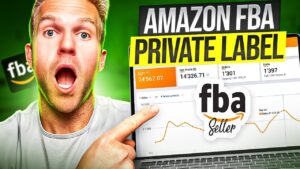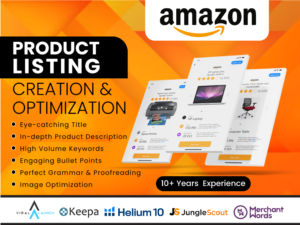A Beginner’s Guide to Amazon Private Labeling in 2025
Introduction
Among the most successful eCommerce tactics nowadays is Amazon’s private label business concept. 2025 is the ideal year to launch your own private label brand on Amazon, regardless of your level of experience as a seller. Amazon Private Label 2025 This manual will take you through the fundamentals and provide you with a clear path to success. Amazon Private Label 2025
Amazon Private Label: What is it?

It is the process of buying general merchandise from manufacturers, changing the brand and selling it on Amazon as your own brand, this is called Amazon private labeling. This enables vendors to distinguish themselves from other vendors and to develop a solid business.
-
In 2025, Why Opt for Amazon Private Label?

Amazon Private Label 2025
- Less Competition – Amazon’s algorithm is favoring private label brands over resellers.
- Higher Profit Margins – You set your own price and brand value.
- Scalability – A private label business can grow into a full-fledged brand.
- Greater Brand Control: You are in charge of the listing, branding, and pricing, unlike with wholesale or arbitrage.
Step 1: Product Selection and Market Research

Amazon Private Label 2025 The secret to your success is choosing the correct product. To examine market trends, you should use some programs like AMZScout, Jungle Scout, or Helium 10.
• Seek out goods with less competitors but a strong demand.
- Avoid trademarked or patented products.
- Choose products with room for improvement based on customer reviews.
Step 2: Sourcing Your Product

Once you know what your product is, you should then try to get a reliable supplier: Some suggestions are; Use sites like Alibaba, Global Sources, or ThomasNet.
- Request samples before placing a bulk order.
- Discuss shipping conditions, minimum order quantities (MOQ), and prices. .Verify that the manufacturer provides packaging customization and private labeling.
- Discuss shipping conditions, minimum order quantities (MOQ), and prices.
• Verify that the manufacturer provides packaging customization and private labeling.
Step 3: Packaging & Branding

That which makes you unique is your brand. First of all, let’s focus on: • Creating a separate and easy to remember brand name. • Creating a logo and packaging that are visually appealing. • To get further protection and additional benefits, register your brand on Amazon Brand Registry.
Step 4: Creating an Amazon Listing

Your listing should be optimized for both search rankings and conversions:
- Use a title that is full of keywords.
Compose an engaging product description emphasizing the main advantages.
• Include excellent photos and infographics.
- Use A+ Content (formerly Enhanced Brand Content) for better engagement.
Step 5: Launching & Marketing Your Product

To gain traction, use a combination of:
- A learn to humanize the following text in its original language. Product Description: Key benefits •Pairs well with high-quality images and infographics..
• Include infographics and excellent photos.• Pay-Per-Click (PPC) advertisements on Amazon to increase traffic.
• Using social media marketing to raise brand recognition.
- Influencer collaborations for authentic reviews.
- Email marketing to nurture customer relationships.
- Discount campaigns or limited-time offers to attract early buyers.
Step 6: Managing Inventory & Fulfillment

Amazon offers different fulfillment options:
- Fulfillment by Amazon (FBA): Amazon manages customer support, delivery, and storage.
• Fulfillment by Merchant (FBM): You are responsible for shipping and fulfillment. Third party Logistics (3PL): Outsource fulfillment for flexible options.
Step 7: Customer Service & Getting Reviews

- Your private label firm might succeed or fail based on positive client reviews:
Deliver first-rate customer service and promptly address questions.
- Follow up with customers via email and request honest reviews.
- For maintaining a strong reputation, refund or replace to the dissatisfied customers. First, get initial feedback from Amazon’s Early Reviewer Program or Vine Program.
Step 8: Scaling Your Private Label Business

Once your first product is successful, expand by:
- Introducing complementary products to build a brand line.
- Optimizing existing listings to improve sales.
- Expanding to international Amazon marketplaces.
- Building your own eCommerce store outside of Amazon for long-term stability.
Common Mistakes to Avoid in Amazon Private Label
- Choosing an overly saturated product.
- Ignoring customer feedback.
- Not investing in branding and marketing.
- Running out of stock due to poor inventory planning.
- Relying solely on Amazon ads without organic marketing.
- Skipping proper legal registrations, leading to trademark issues.
Conclusion
In 2025, private labeling on Amazon will still be a profitable option for business owners wishing to establish their own identity. You may build a profitable and long-lasting company on Amazon by carrying out in-depth research, locating premium goods, and putting sound marketing techniques into practice. FAQS
How much does it cost to start a private label brand on Amazon?
The initial investment is usually between $1,500 and $6,000 for: • Amazon Professional Seller Account: The expenses that are associated with having access to Amazon’s selling platform. • Inventory and Samples: The purchase of the first stock and the product samples. • UPC Codes: These are product identifiers that are needed when listing a product on Amazon. • Shipping: All the costs that are incurred in the process of moving the products to the fulfillment centers. • Product Photography: High-quality images to enhance product listings. • PPC Advertising: Paid campaigns to increase product visibility. • Optional Expenses: Other costs include training, inspection, and others.
How can I market my Amazon private label brand?
• Amazon PPC Advertising: This is the use of pay per click advertising to help products • Social Media Campaigns: You should interact with page administrators and come up with strategies to post content that will encourage people to buy your products. • Optimized Listings: It is crucial to have properly written product titles, descriptions, and images that are SEO friendly. • Customer Engagement: Ask your customers to post their feedback and answer their questions as soon as possible to gain their trust.
How do I find profitable niches for private labeling on Amazon?
To identify profitable niches: Utilize Research Tools: Use the Amazon Best Sellers list and other product research tools to determine which products are most popular and have low competition. • Analyze Customer Reviews: Look for the wants and needs of the customers or areas that could be improved in order to make your product stand out.


👍
Nice
Good
Nice
Amazing
Nice
Amazing
👌🏻
👌
Great
👍well done
Private labeling on Amazon seems like a promising way to build a business, but it’s not without its challenges. Choosing the right product is crucial, and tools like AMZScout and Jungle Scout can definitely help with that. Finding a reliable supplier is another key step, and platforms like Alibaba seem like a good starting point. Optimizing listings for both search and conversions is something I’d need to focus on to stand out. The initial investment of $1,500 to $6,000 seems reasonable, but I wonder if there are hidden costs I should be aware of. How do you ensure that the product you choose will actually sell well in a competitive market like Amazon?
**Private Label Selling on Amazon: A Guide to Success**
Private labeling on Amazon involves buying products from manufacturers, rebranding them, and selling them as your own. This strategy allows sellers to differentiate themselves and build a strong brand. Here’s how to succeed:
### 1. **Choose the Right Product**
– **Analyze Market Trends**: Use tools like AMZScout, Jungle Scout, or Helium 10 to identify profitable products.
– **Identify Demand**: Look for products with consistent demand and relatively low competition.
### 2. **Find a Reliable Supplier**
– **Use Platforms**: Check sites like Alibaba, Global Sources, or ThomasNet for suppliers.
– **Evaluate**: Ensure suppliers are reliable for quality and consistency.
### 3. **Optimize Your Listing**
– **SEO**: Use relevant keywords to improve search rankings.
– **Conversion**: Write compelling product descriptions and showcase high-quality images.
### 4. **Fulfillment Options**
– **FBA**: Use Amazon’s Fulfillment by Amazon for storage and shipping.
– **FBM**: Use Fulfillment by Merchant for more control over the process.
### 5. **Expand Your Business**
– **New Products**: Once your first product is successful, introduce more products.
– **Marketing**: Use PPC advertising and other strategies to increase visibility.
### **Initial Investment**
– **Account**: Set up a professional Amazon seller account.
– **Inventory**: Buy initial stock and product samples.
– **UPC**: Purchase UPC codes for product listings.
– **Shipping**: Handle costs for moving products to fulfillment centers.
– **Photography**: Hire a photographer for high-quality product images.
– **PPC**: Allocate funds for Pay-Per-Click advertising campaigns.
– **Optional**: Consider other costs like training and inspections.
### **Identify Profitable Niches**
– **Research**: Use market analysis tools to find niches with high demand.
– **Trends**: Stay updated on market trends to adapt strategies accordingly.
By following these steps, you can successfully launch and grow your private label business on Amazon.
Private labeling on Amazon seems like a promising strategy for building a unique brand. The emphasis on choosing the right product and using tools like AMZScout is crucial for success. Finding a reliable supplier through platforms like Alibaba is a smart move, but how do you ensure quality control? Optimizing listings for search rankings and conversions is essential, but I wonder how much time it typically takes to see results. The initial investment range of $1,500 to $6,000 seems reasonable, but are there hidden costs to be aware of? Expanding after the first product’s success is logical, but how do you manage scaling effectively? Overall, this approach seems well-structured, but I’d love to hear more about the challenges you’ve faced in this process.
We’ve integrated libersave into our regional voucher system. It’s amazing how easily it allows us to bundle different providers on one platform.